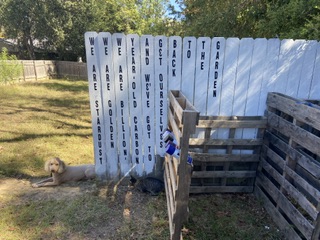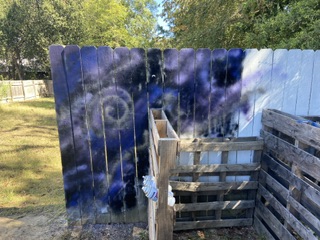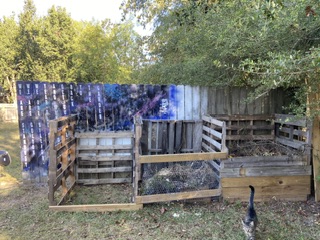Consider the leaf. Around this time of year (in the Northern hemisphere), a lack of chlorophyll reveals yellow and orange pigments in leaves that are masked by green tones in warmer months. A combination of cooler night temperatures and sunny days create optimum conditions for trapping sugars in leaves, allowing anthocyanins (pigments found in plants) to develop and enhance colors. In a short time, deciduous tree will lose those colorful leaves so that the tree can conserve energy through the harsh winter by keeping moisture within the trunk. Winter winds can howl through the naked branches without putting additional strain on tree, ensuring these ancient sentries survive another season.
Nature, in her infinite wisdom, wastes nothing. The leaves fall at the tree's base where they will break down and provide the tree with EXACTLY the right type and quality of food to sustain the tree EXACTLY when it needs it. Worms, snails, bees, and microscopic decomposers like fungi and bacteria makes their homes in the rich leaf litter. If left undisturbed, the fallen leaves of autumn break down into rich leaf mold - unparalleled for growing basically anything. Exactly the kind of stuff you want around come spring. It's almost like it's meant to be!
Unfortunately, in 1947 an invasive species that feeds exclusively on fallen leaves made its first appearance. Since then, an unchecked epidemic has ravaged the American landscape. Ictu folium, or in the common tongue, the leaf blower. Surely the leaf blower is one of the most detestable and irritating sounds created by man, including New Wave Synth. It has all the great qualities lawn companies look for: you can only use it for one task, it's cumbersome, terribly inefficient, and above all, unnecessary. Instead of letting the biodegradable leaves sit a dance out after jumping to their great reward, humans will needlessly toil for hours on a beautiful Saturday bagging nature's bounty up in giant plastic bags that will never go away. Fun fact - did you know every last bit of plastic that has ever been made is still around? Ok, it's not a fun fact, it's a depressing fact, but it's the truth. Single use plastic is the scourge of the modern age. But I digress, this post is about compost.

In my former life as a history teacher, a favorite beginning of the year introduction to archeology was excavating a trash can. We spent a good deal of time determining what trash would still be around for future generations, and what would waste away over time. You can tell a lot about a civilization by what it throws away. Most of what you look at in a museum (when we are talking about ancient civilizations) was thrown away. Bits of pottery, glass beads, bone handles on tools, our ancestors left very little trash. If it was made on earth by earth (plants, animals, minerals, etc.) it will break down into it's components and return from whence it came. Whether it's the eggshell from breakfast, your favorite dog under a live oak, or a pioneer felled by dysentery when he tried to ford the river. (Damn you, Oregon Trail!) Ashes to ashes, dust to dust, presto change-o, it all starts and ends with dirt. Dirt, soil, compost, whatever you want to call it, the life giving crust that ensures survival on Earth, we gotta feed it to replace what we take out of it.
As a newly minted gardener, I was eager to finally have a real compost pile of my very own. To show the universe I was serious, I bought a thick tome from a great authority. It has very excellent and science-y illustrations of cells captioned with sentences like:
"Colloidal humus particles are negatively charged and attract positive elements such as potassium, sodium, magnesium, iron, and copper."
It took me 6 weeks to read it because it put me to sleep so easily and I started looking ahead for pictures to motivate myself. I'd savor the pictures like raisins in stale trail mix. I will tell you this from the book - basically all civilizations for all time have had natural and sustainable ways for building up depleted soil with compost. And they didn't involve a plastic wrapped bag of chemical compounds.
I will now perform the magical task of condensing all 391 pages into six words for you:
Chuck your rubbish in a pile.

It's that easy, I absolutely promise. You can bog yourself down with formulas, ratios, expensive gadgets, temperature gauges, whatever you feel like stressing yourself out with this week, but at the end of the day all you really have to do is get out of the way and let nature do it's thing. I tell you this as someone who has read dry 391 page volumes starring carbon. Composting will make your garden better, your environmental footprint smaller, and your life easier. I should also warn you that composting is a homesteading gateway drug to keeping rabbits or chickens, but that is for another post.
Here are the things I worried about before I pulled the compost trigger: Will it smell? Will the stuff actually break down? Will I get a bunch of bugs and scary creepy crawlies in it? Will the rats from the Secret of NIMH start camping out in my garden and stealing my electricity? Will it be worth it?

After several years and attempts I can safely say the answers are: No, yes, kind of, no, and YES!
My first prototype was a raised bed I made from closet doors I pulled out. I used L brackets to screw them together and just started throwing leaves, food scraps, and garden cuttings in it. Here is a picture with my discarded Halloween pumpkins perched on top looking extra jolly and still going strong last January. The "Good Enough" fence was still under construction, and as usual, my projects are strung out all over the yard.

Yes, dear reader, I literally just let a pile of garbage decompose in my front yard for all the world to see. I didn't turn it, I didn't measure it, I didn't worry about it, I just chucked stuff in and walked away. This past spring, when I wanted to take down the old beds and build something a little more permanent, I eyed the trash heap skeptically. Some pulled vines where browning on top; I gingerly stuck my pitchfork into the pile, convinced I would spear 1000 furry rats and lifted the dried canes from the top. Friends!... the richest, wormiest, loveliest soil was humming away underneath the top layer crust. I almost stuck the same pitchfork into myself to make sure I was awake. It was garden magic and I wish for you to experience the same magic for yourself someday.
Even for me, having a pile of rubbish front and center bordered on a little much, so I decided to go bigger and relocate the pile to a corner that was closer to the chicken coop. I used 3 old pallets and some scrapped fence planks and built what I call a stall. The bottom is just the ground - you want ground contact for compost, trust me.

The planks on the bottom facing front were more to keep Roosevelt out because he is disgusting and loves rolling in smelly garbage as well as eating rabbit poo. I know, it's gross, but he has many other endearing qualities. I quickly outgrew just one stall, because I murder so many plants. I built two more, again using pallets and scrap wood. I spent 0 dollars on the whole setup. Into the stalls I dump wheelbarrow loads of spent plants, shavings from the chicken coop, the bun's litter box, leaves, and food scraps. I could also put newspapers or cardboard but I save those for the bottoms of my raised beds. Instead of buying something fancy to hold my scraps in the kitchen, I just walk out after supper and make a nightly deposit.

I love my compost pile. I still have to buy and bring in additional manure and soil, but my hope is eventually I will close my little eco-loop, so I can quit spending my hard earned bucks on literal poo to make my dirt happy. All of your enormous rubbish heap will turn into a teeny tiny precious pile about 1/50th the size of what it was originally. That's ok, that's also part of nature's plan. What you are left with is a mega-Flintstone chewable for your garden; just pure concentrated goodness.
I love my compost pile less for what I get out of it and more for what I can put into it. I think it is the most beautiful place in my garden because it's always becoming. It is less a place of dumping something unwanted and more a place of offering. I knew a compost pile would give me good stuff to feed my plants, but I never thought it would give me the sense of peace it has.
I painted a mural around my compost corner. I envisioned it as a sort of Shangri-la for plants. First I white-washed the fence, then I spelled out in adhesive mailbox type letters lyrics from the Joni Mitchell song (made popular by the Crosby, Stills, Nash & Young version) "Woodstock." This part was a tremendous pain in the ass because I had to figure out how many of each letter I needed and then stand in Lowe's and fail at fourth grade math reading the packets. I used some backwards 3s as Es. I'm ok with it.
Then I painted over the whole thing with spray paints I had on hand, I used black, dark purple, silver, light purple, and dark blue. This was stressful as the vinyl letters rejected the fence surface and started peeling up even after I rubbed an old Starbucks card over them with great intensity. I held my breath and peeled the letters off as soon as I got them all covered in paint and was happy that they were legible.
It didn't look enough like a galaxy to me so I consulted my daughter who really is the best crafting buddy and consultant for all arty projects. Per her advice, I went in with some outdoor acrylic paints I had, adding pinks, light blues, and more black. I scrunched up a newspaper to apply the paint. The most fun part was loading up a dry paintbrush with white paint and flinging it to make stars. If you try to paint stars in a random pattern, it will look anything but random. The spattered paint work ends up looking much better. It made a terrific mess and also got the pets riled up. You can see Tiny Murder Kitty (Minou) and Roosevelt in the last picture trying to crunch on my fun vibes during the creation of the stars.
This lil project gave me the perfect excuse to listen to Deja Vu on repeat which is really just a great album and gift to humanity. I strongly recommend zoning out to the harmonies in Helplessly Hoping ( Crosby, Stills, & Nash, 1969) while painting a galaxy for your compost pile and contemplating the staggering inevitability of the cosmos. I spent about $25 on 5 packs of vinyl letters and I have lots leftover for the future crackpot ideas I am bound to have. Everything else I already had on hand.

So listen, I told you how I did it. I made a compost system that works for my garden and logistics. If you want to learn more or do it differently, you'll figure it out. People much smarter than me have written easy to understand rules and guidelines for composting. Go wild. Or go break your back and waste a some of the best weekends of the year putting biodegradable leaves into a huge plastic bag for no good reason.



